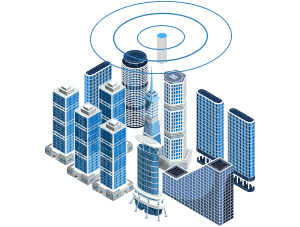Cellular connectivity is akin to digital oxygen. Lack of cellular connectivity leads to most kids, teens, and adults languishing audibly. Cellular reception is now one of the top three reasons tenants and building occupants search for new places to lease. And good cellular connectivity is worth paying for. Studies indicate that tenants are willing to pay up to $1.50 extra per leasable square foot if the space they are renting does indeed for uninterrupted, seamless cellular coverage.
Both businesses and non-business tenants need excellent cellular connectivity at all times. Mobile devices have long since become integral parts of our lives, and our reliance on them is increasing. With the advent of 5G, IoT, and other industry-specific technological solutions, connectivity requirements forecast massive increases, and businesses will be leading the charge. Why? There are simply too many benefits. Read on.
What is Cellular Enhancement?
Before we get into the benefits of ultra-smart workplaces, it’s essential to understand what cellular enhancement means. In simple words, cellular enhancement brings outdoor cell signals inside. When cellular towers broadcast signals, waves that travel further and have more obstructions become weaker. Think of it like this, the very building you are in and its building materials are blocking the cellular signal from coming in. We’re all too familiar with the results – slower phones, dropped calls, poor voice quality, and the overwhelming use of the phrase “Hello? can you hear me?”
Well, cellular signal enhancement solutions like DAS, small cells, and boosters solve this very problem. These solutions increase in-building signal strength by capturing the outdoor signal from nearby towers, amplifying them, and rebroadcasting the enhanced signal indoors. An exterior antenna is installed on the building to capture the signal, and the amplified signal is re-broadcasted using antennas located inside the building.
DAS coverage solutions are among the best cellular enhancement solutions available. Many businesses are shifting to DAS to create a seamless, connected in-building network. Since DAS is a scalable, future-proof, and turn-key solution, business owners are keen on deploying custom-built DAS solutions.
Business Benefits of Good Cell Signal
Cell phones are slowly becoming the only device you need a pocket for, except tissues. They are our wallets, fitness trackers, verification & two-factor authentication devices, a messaging device, and a whole lot more. Most importantly, they have all our apps. According to Apperian, 53% of executives agree that apps improve business processes and productivity. Similarly, a poor signal can lead to slow internet, dropped calls, and spotty voice quality, all of which lead to disgruntled customers and employees. In a nutshell, if you’re looking to improve employee morale and focus while better customer experience, you need seamless cellular connectivity.
Cellular signals are also necessary for emergencies. National Emergency Number Association (NENA) found 80% of all emergency calls come from wireless devices. And in-building public safety has guidelines that all businesses need to follow. If your building or campus has poor cellular connectivity, enhancing the overall network availability is a necessity, not a luxury.
All this is irrespective of industry. Depending on your career, cell connectivity and emerging technologies can combine to make your life extremely easy. Additionally, commercial buildings and homes retain more tenants if their location isn’t a signal dead zone.
5G & IoT – How Businesses are Using Them
As businesses grow competitive, reliance on technology and connectivity only increases. Today, every industry is leveraging IoT, AR/VR, AI, and the principles of Industry 4.0 to create connected, seamless experiences. Whether it’s at a stadium or in a hospital, businesses are leveraging IoT technologies to give themselves a competitive edge over other players in the market.
As businesses embrace more devices and IoT services in their workplace, workers will enjoy greater flexibility, enhanced workflows, improved communications, and higher productivity. This streamlined, organized, process-driven workplace demands interconnected technologies that modern cellular requirements simply cannot meet.
These factors are why businesses are building their own private 5G networks. Smaller devices and outdoor sensors cannot rely on Wi-Fi due to power requirements. Cellular reception also allows devices to reserve power, last longer, and exist outside of the building. If campus/building security is vital in your workplace, installing a DAS system may be the best way to proceed.
No Cellular Connectivity, No Business
As buildings and businesses get more automated processes and fixtures, connectivity will be the difference between successful businesses and the rest. Smart buildings are here to stay, and not upgrading soon can have huge repercussions on your business. Not only will they help reduce the cost of operation, but they also provide a better experience for everyone in them—a win-win for both building owners and tenants/businesses.
That said, in-building connectivity solutions aren’t as readily available as Oreos. There are factors to consider while choosing in-building connectivity solutions like scale and location. We’ve also written a blog about things to keep in mind while selecting a connectivity partner. Lastly, we at KT coverage have a proven track in creating state-of-the-art connectivity solutions. Our team of experienced engineers and network designers are always happy to help you out.



Post a comment